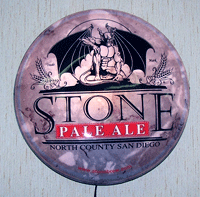Breweriana has been come to be known as the collectable detritus of brewing’s past. The term breweriana first appeared in the U.S. as the 1972 founding of the National Association of Breweriana Advertising. Most beer fans consider old beer signs, neon signs, advertising bills, old rusty beer cans, pint glasses, t-shirts, patches, or anything with a brewery’s logo on it to be breweriana. The collectiblility potential of breweriana is easy to see – some people have been able to make a great deal of money through the sale of breweriana antiques.
Breweriana is a popular field of collectables for a couple of reasons. Firstly, as with most collectables, is nostalgia. To determine the nostalgic value of an item you must look at how trivial items play through history. The item must also be authentic to be worth much. Knock off nostalgia items tend to break the spell of nostalgia eventually. As with other fields, in the area of breweriana, it is important to look at discontinued items.
Another reason why it may be profitable to trade in breweriana is that many bars look for these ancient items when assembling their décor. If you run across a big sign or neon from an antique dealer or scrapyard hustler, you might be able to turn a profit by inquiring at local pubs and the hipper dive bars. The antique décor motif is one used in curiosity shops, bars, and even big chain stores like the cracker barrel.
When looking at breweriana, it is a good idea to find out about the location of the brewery that first created the breweriana. Regionally, breweriana from closed down and defunct breweries is more valuable than it is nationally. This is because more people recognize the name brand of their once-local brewery or brewpub. It is a good bet that an old beer sign can fetch a better price in the state that it was originally displayed.
There are many folks that collect beer cans and bottles from the past. These items must be handled with care, as the beer contained within (if any) has often undergone a hideous transformation. Most collectors drill a small hole in the bottom of the can and drain the sometimes-noxious contents before setting the collectable on the shelf. Bottle caps can be pried off carefully and re-applied to achieve the same effect.
Keep a look out for older cans. Cone tops, crowntainers, and flattops are among the most valuable. Cone tops and crowntainers both have a cone like top, which was usually capped with what we cap bottle caps these days. Flattops had no tab and required a bottle opener to get at the beer inside. “Instructionals” is the term for flattops that have instructions for opening listed on the side of the can.
Some of these cans, the earliest from the Krueger Company, required their own can openers. Flattops had no tab and required a bottle opener to get at the beer inside. The "flattops" needed a regular can opener, the sharp lever-pry type. Some of these collectibles (the openers) are usually formed from a piece of steel rod which loops around and is about 5-6 inches long. Usually the beer can openers have a stamp from the beer manufacturer. One of the more popular pieces of breweriana among private collectors is the crown, or bottle cap. Bottle caps were initially manufactured in the 1890’s. Those that survived through prohibition are the hardest to find, and most of those are from defunct breweries.
Beer signs, or even posters, are another hot item, mostly because they are sought after by bars and pubs to add to their décor. Some older signs look like posters but have been printed on sheet metal. We can see reproductions of these items out on the market as well, such as the old Guinness mascot, the beer-swilling Toucan. The original designs are worth a lot, not so much for the reproductions.
When looking for breweriana, make sure you know what you are looking at. There are many books out on the subject now, such as Beer Signs for the Collector and the Beer Advertising Memorabilia series. A visit to Amazon.com or your local library will give you some insight on this field of antiques.
See related:
Breweriana: Collectible Beer Signs
Breweriana: Collectible Pint Glasses
Breweriana: Specialty Beer Glasses
Breweriana: Collectible Beer Steins



